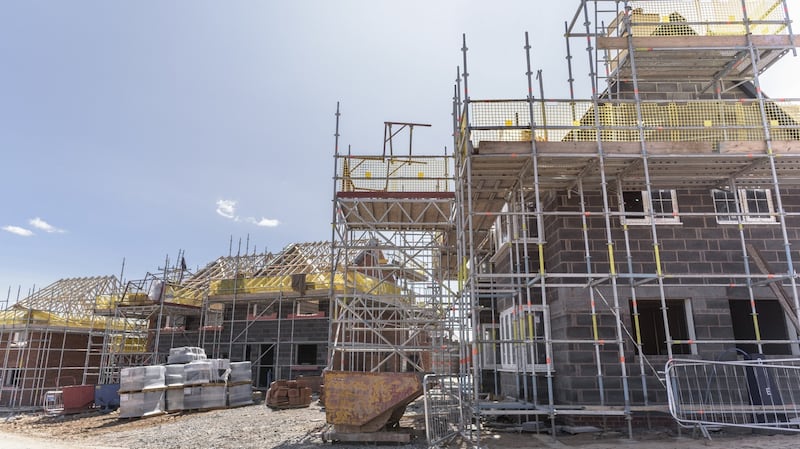Another month and another acceleration in the rate of property price increases, this time to 14.4 per cent.
The headline figures are clear and point to worsening affordability, driven by chronically short supply in key areas of the market.
But what are the key trends behind the figures which will determine what happens from here?
1. Behind the price trends
The figures show a 14.4 per cent national increase with Dublin prices up 13.1 per cent and those outside the capital up 15.4 per cent.
A notable gap has opened between new and second-hand properties, with new home prices up 5.1 per cent year on year and second-hand up a striking 16.7 per cent – in part this may reflect people bidding on second-hand properties due to the lack of availability of new homes.
While new-home prices have risen by 81.6 per cent since their post-crash trough in 2012, second hand properties are now up by 115.8 per cent. As Dermot O’Leary, Goodbody economist commented in a note on the figures: “There has rarely been a better time to be a seller in Ireland.”
Estate agents Sherry FitzGerald attribute the stronger trend outsider the capital in the second-hand market in part to generally lower prices meaning Central Bank borrowing rules do not offer the same constraint.
Covid-19 induced relocations outside Dublin are also a factor, making larger more spacious properties popular.
Overall transaction levels in the market are back at 2019 levels – and are slightly stronger in the second-hand market, where supply has been a bit higher.
O’Leary of Goodbody also notes the 20 per cent increase in transactions versus 2019 in the sector defined as “non-household purchases”– mainly the public sector including local authorities and approved housing bodies for social housing provision and by investment funds, as well as some private landlord purchases (though Sherry FitzGerald figures suggest that three times as many private landlords are selling as are buying).
Household purchases of new homes – people buying homes to live in were down 11 per cent on pre-pandemic levels compared to a 6 per cent rise in the second-hand market.

The impact of the build-to-rent sector will remain a key area for debate. John McCartney, director of research at BNP Paribas, calculates that investment funds have bought 16,000 of the 117,288 new homes sold in Dublin since 2016; 9,500 of these were built with pre-committed funding from investors and he argues many may simply not have been constructed otherwise.
2. Where are we now?
Prices on average remain below the 2007 peak by about 4 per cent. In Dublin, the gap is larger at 11.3 per cent. What does this tell us about the market?
ESRI research professor Kieran McQuinn previously calculated that prices went from being heavily overvalued before the financial crash – by around 40 per cent based on economic fundamentals – to sharply undervalued afterwards.
A paper by McQuinn and Central Bank economist David Cronin estimates that house prices were roughly in line with economic fundamentals in late 2019 before the pandemic hit.
While house prices are rising again after flattening in 2020, McQuinn says there is no reason to think there are out of line with fundamentals, with demand also growing and supply constrained.
“My hunch is we aren’t in bubble territory,” in terms of prices, he said, and there is certainly no credit bubble, with household debt levels down sharply since the financial crash.
One danger, he says, would be an expectation building that sharp increases were here to stay, with people buying in the belief that prices would be higher in six or nine months.
3. Where are prices going?
As ever with housing, views differ on where prices are heading. But most see further rises in the short-term.
McQuinn believes that prices will continue to rise this year before supply catches up and possibly leads to some easing into 2023. Marion Finnegan, managing director of Sherry FitzGerald expects house price growth of 5 to 6 per cent in Dublin and 10 per cent plus outside Dublin, with supply remaining tight though expected to pick up as the year goes on, notably in the new homes markets.
John McCartney, however, points to the slowing of price growth in the run up to the pandemic, driven he says by increasing supply, which had increased sharply between 2013 and 2019.
While the pandemic disrupted supply, he expects to see house price growth moderate, potentially sharply, as more supply comes on stream, with his calculations estimating there are 16,000 new homes under construction in Dublin at the moment and 32,000 nationwide.
In many markets, Covid-19 seems to have caused something of a mismatch between supply and demand and a surge in prices as the worst of the pandemic passed.
This may also be linked to the general rise in inflationary pressures, a point underlined this week by ECB board member Isabel Schnabel.
Like general inflation, most forecasters expect house price growth to slow, but how quickly is a key issue.

4. A shortage of affordable homes
Supply looks set to pick up in 2022 and this will be a driver in house price inflation. But affordability remains a key factor and in a multi-faceted housing market we are looking at a whole range of interconnected markets for different types of properties.
Irish economist Dara Turnbull, who is research coordinator at Housing Europe, the European federation of public, co-operative and social housing in Brussels, says that the house price data for Dublin city suggests a lack of lower priced homes coming on to the market at the moment.
He compares trends in the house price index from the CSO – which adjusts for different types of properties – and the headline house prices, based on market transactions, which are rising more quickly.
This suggests that part of the topline price inflation is driven by people buying more bigger properties – in large part presumably because of lack of supply in the cheaper end of the market. Looking at Dublin City and County figures he says:
“If my workings are correct then it suggests that what is coming to market in Dublin is not really representative of the overall housing stock in the county, with few lower priced units available to purchase.
This might reflect that some of those currently occupying relatively less expensive homes are unable to trade up, or are else just uninterested in doing so, and we therefore aren’t getting the turnover of stock needed for a well functioning housing market”.
This suggests both that the market is partially “struck” and that the average price of a house in Dublin may be inflated by the lack of supply of cheaper properties, which would sell if available.
This sounds like common sense, but the key policy challenge is to provide a supply of houses at more affordable prices. We are likely to get more supply over the next couple of years and significant public money will go behind this in some areas.
This will be very welcome, but the second part of the challenge is to use the public funding to provide houses which more people can afford.














